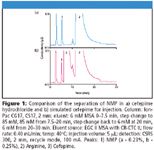Determination of N-Methylpyrrolidine in Cefepime Using Reagent-FreeTM Ion Chromatography
Cefepime is a fourth generation cephalosporin (1). During preparation and storage, cefepime degrades by release of the N-methylpyrrolidine (NMP) side chain and opening of the beta-lactam ring. An NMP concentration increase will directly affect the potency of the active component of the drug. Therefore, it is critical to determine the amount of NMP in cefepime. The US Pharmacopeia (USP) monograph specifies the limit of NMP to <0.3% in cefepime hydrochloride and <1% in cefepime for injection (2,3). The latter is a dry mixture of cefepime hydrochloride and L-arginine. The current USP method uses cation-exchange chromatography with non-suppressed conductivity detection to determine the limit of NMP in cefepime. There are several disadvantages to this method, such as the ~3-4 h time required per injection, a lack of retention time stability for NMP in standard and sample solutions, and a lack of sensitivity. In this paper, we describe an improved method using a hydrophilic, carboxylate-functionalized cation..
Brian De Borba and Jeff Rohrer, Dionex Corporation
Cefepime is a fourth generation cephalosporin (1). During preparation and storage, cefepime degrades by release of the N-methylpyrrolidine (NMP) side chain and opening of the beta-lactam ring. An NMP concentration increase will directly affect the potency of the active component of the drug. Therefore, it is critical to determine the amount of NMP in cefepime. The US Pharmacopeia (USP) monograph specifies the limit of NMP to <0.3% in cefepime hydrochloride and <1% in cefepime for injection (2,3). The latter is a dry mixture of cefepime hydrochloride and L-arginine. The current USP method uses cation-exchange chromatography with non-suppressed conductivity detection to determine the limit of NMP in cefepime. There are several disadvantages to this method, such as the ~3-4 h time required per injection, a lack of retention time stability for NMP in standard and sample solutions, and a lack of sensitivity. In this paper, we describe an improved method using a hydrophilic, carboxylate-functionalized cation exchanger with suppressed conductivity detection to determine NMP in cefepime. Compared to the current USP method, the proposed method significantly reduces the time between injections, thereby improving sample throughput.
Experimental
- Dionex ICS-3000 Reagent-Free ion chromatography (RFIC™ ) system consisting of a DP dual gradient pump, EG eluent generator with an EGC-MSA cartridge and CR-CTC II, and a DC detector compartment with dual temperature zones.
- IonPac® CG17 guard (2 × 50 mm) and CS17 analytical (2 × 250 mm) columns with a flow rate of 0.40 mL/min at a column temperature of 40°C. Analytes were detected by suppressed conductivity with a CSRS 300 (2-mm) operating at 100 mA in the recycle mode.
Results and Discussion
The proposed method was used to determine NMP in USP-grade cefepime hydrochloride and a simulated cefepime for injection samples. The average NMP concentration detected in cefepime for three independently prepared solutions over three consecutive days was 0.236 ± 0.003%, which meets the current USP specifications. Interday retention time and peak area precision over three consecutive days (i.e., day-to-day, n = 30) were 0.5% and 1.5%, respectively. The accuracy was evaluated by spiking three different concentrations of NMP in cefepime, which produced average recoveries of 98–102%, suggesting the method is accurate. A simulated cefepime for injection sample solution was prepared by combining 10 mg/mL cefepime hydrochloride with 7.25 mg/mL arginine. The combination of arginine and cefepime significantly increases the analysis time required for each sample using the USP method. However, no time difference was observed for the determination of NMP in cefepime hydrochloride and cefepime for injection using the improved method (Figure 1).

Figure 1
Conclusion
The results demonstrate a significantly improved method for the determination of NMP in cefepime. The method separates NMP in <10 min and efficiently removes cefepime from the column, which allows significantly lower analysis times and good retention time stability relative to the current USP method.
References
(1) U.S. Food and Drug Administration. "MaxipimeTM : (Cefepime Hydrochloride) for Injection." NDA 50-679/S-021. http://www.fda.gov/medwatch/SAFETY/2003/03MAR_PI/Maxipime_PI.pdf (accessed November 14, 2007).
(2) United States Pharmacopeia. The National Formulary. "Cefepime Hydrochloride." USP 31, NF 26, 2008 p. 1669.
(3) United States Pharmacopeia. The National Formulary. "Cefepime for Injection." USP 31, NF 26, 2008 p. 1670.
Maxipime is a registered trademark of Bristol-Myers Squibb Company. Reagent-Free and RFIC are trademarks and IonPac is a registered trademark of Dionex Corporation.

Dionex Corporation
1228 Titan Way, P.O. Box 3603, Sunnyvale, CA 94088-3603
tel. (408) 737-0700, fax (408) 730-9403

Sorbonne Researchers Develop Miniaturized GC Detector for VOC Analysis
April 16th 2025A team of scientists from the Paris university developed and optimized MAVERIC, a miniaturized and autonomous gas chromatography (GC) system coupled to a nano-gravimetric detector (NGD) based on a NEMS (nano-electromechanical-system) resonator.

.png&w=3840&q=75)

.png&w=3840&q=75)



.png&w=3840&q=75)



.png&w=3840&q=75)



















